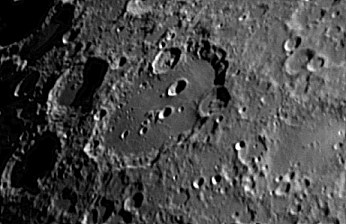|
The
Moon is continuously being impacted by objects of different sizes moving at
thousands of kilometers per hour. These objects are mainly fragments coming
from asteroids and comets and are called meteoroids. The Earth also suffers
the impact of these meteoroids, which in most cases are completely destroyed
in the atmosphere before reaching the ground. But since the Moon has no
atmosphere, meteoroids impact the lunar surface at high speed. So these
particles are completely destroyed during these collisions giving rise to
brief flashes that can be recorded from Earth by means of telescopes. The
first systematic attempts that were made to identify impact flashes due to
the collision of large meteoroids on the lunar surface by using telescopes
equipped with CCD cameras date back to 1997 (Ortiz
et al. 1999). By
detecting the impact flashes of meteoroids on the Moon we can obtain, for
instance, very valuable
information about the flux of interplanetary matter that impacts our planet.
This technique has one important advantage, as we can monitor a much bigger
area (the Moon's surface) than the region covered when we analyse the interaction of meteoroids with the Earth's atmosphere
by means of meteor-observing stations.
 As
a continuation of the pioneer lunar impacts survey carried out from
Spain in 1997 by Dr. Ortiz (see, for instance,
Ortiz et al. 1999 and
Ortiz et al. 2000), our team is
performing a renewed monitoring of the night side of the Moon by
means of telescopes and high-sensitivity CCD video cameras (see, for
instance,
Madiedo et al. 2010,
Madiedo et al. 2014,
Madiedo et al. 2015a,
Madiedo et al. 2015b). This project
is called MIDAS (Moon Impacts Detection and Analysis System). As
a continuation of the pioneer lunar impacts survey carried out from
Spain in 1997 by Dr. Ortiz (see, for instance,
Ortiz et al. 1999 and
Ortiz et al. 2000), our team is
performing a renewed monitoring of the night side of the Moon by
means of telescopes and high-sensitivity CCD video cameras (see, for
instance,
Madiedo et al. 2010,
Madiedo et al. 2014,
Madiedo et al. 2015a,
Madiedo et al. 2015b). This project
is called MIDAS (Moon Impacts Detection and Analysis System).
The MIDAS Project is currently being
conducted by the
Institute of Astrophysics of Andalusia
(IAA-CSIC) from
four
astronomical observatories located in Spain: Sevilla, La
Hita, La Sagra, and Calar Alto.
MIDAS has been funded by the
following Institutions:

 |